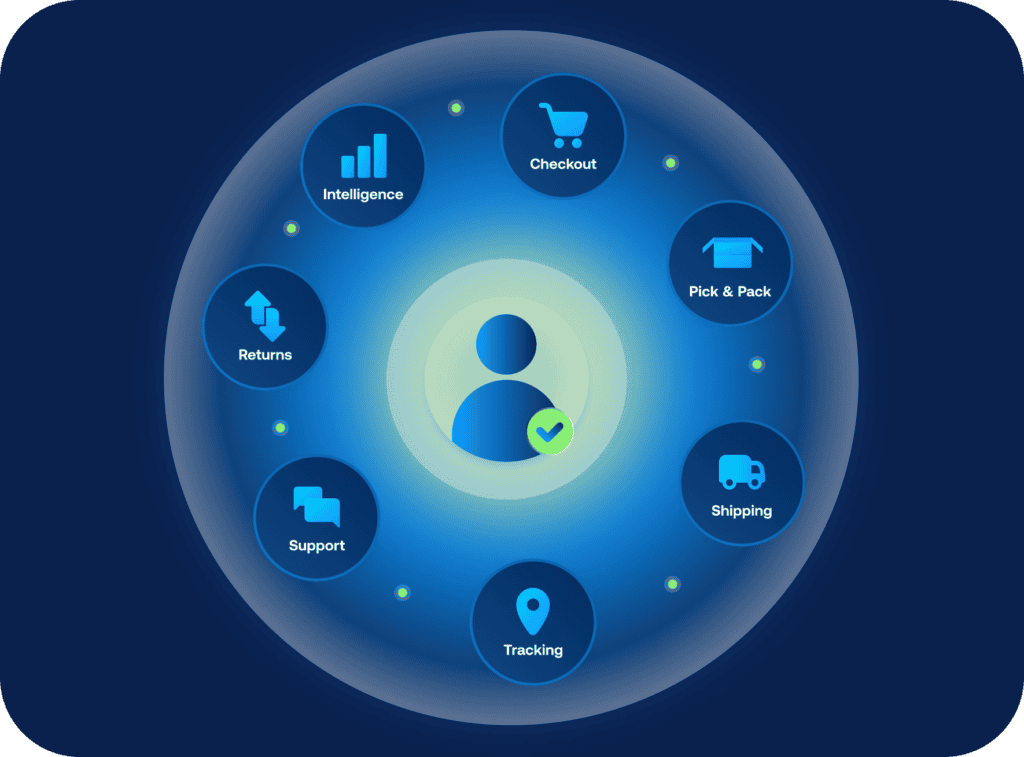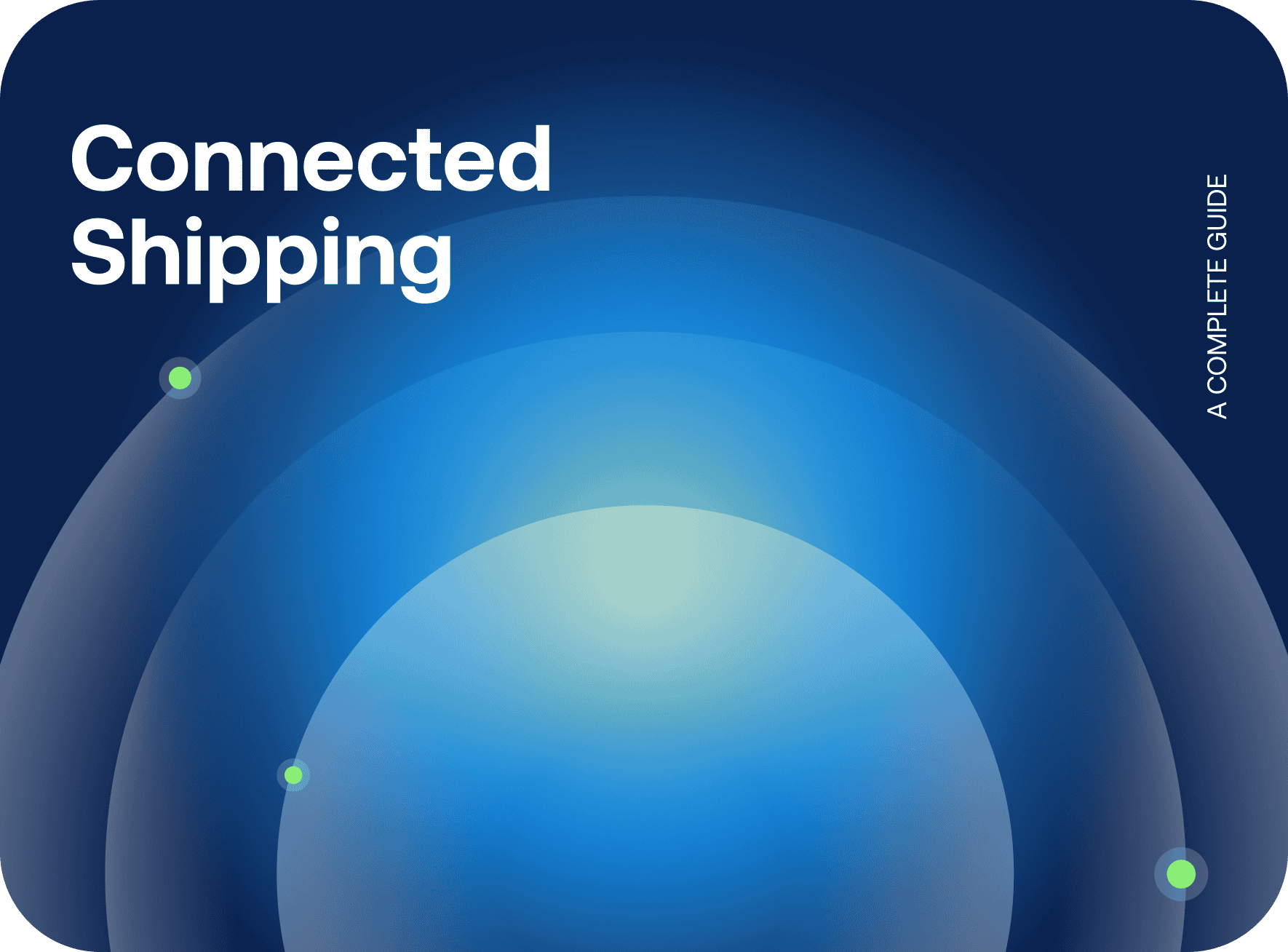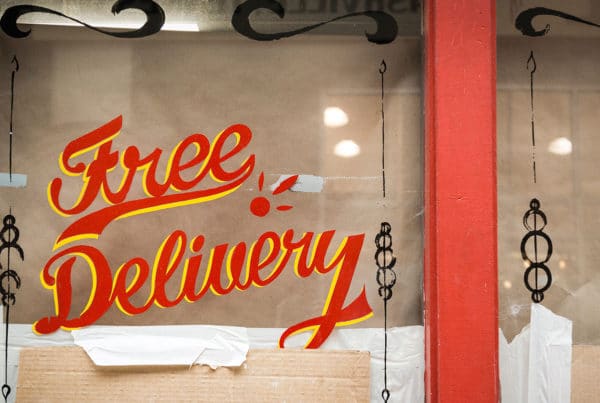Working in e-commerce means juggling countless tasks—orders coming in, customer inquiries flooding your inbox, and of course, shipping. You know that delivering the perfect customer experience is key, but something keeps slipping through the cracks: your shipping process. It’s slow, disjointed, with limited delivery options and zero personalization. And frankly, it feels like a game of whack-a-mole. No wonder customers are left frustrated.
Now, picture a world where all of that changes. Where your shipping isn’t just a box-ticking exercise but an integral part of your customer’s journey—a smooth, fast, and reliable experience that builds trust and keeps them coming back for more. That’s what we call Connected Shipping.
In fact, 85% of consumers say that they’re more likely to return to a store that offers an easy, fast, reliable shipping process. But here’s the kicker: while e-commerce giants seem to have it all figured out, most small and mid-sized businesses are still struggling to keep up. Why? Let’s be real—conventional shipping processes? They just don’t cut it anymore. It’s time to connect the dots!
In this guide, we’ll break down what Connected Shipping really means, why it’s time for your business to hop on board before your competition does, and how to get started. Let’s dive in.
Table of contents
- What is Connected Shipping? Unpacking the concept and why it’s transforming e-commerce
- Old vs. new game: The shift in shipping models
- The benefits of Connected Shipping for different stakeholders
- The role of consumer expectations in shaping Connected Shipping
- Why many e-commerce brands fall short
- How to get started with Connected Shipping
- Conclusion
What is Connected Shipping?

Connected Shipping is more than a logistics upgrade—it’s a game-changer for modern e-commerce. At its heart, it’s about transforming a fragmented shipping process into a cohesive system where every element—checkout, carriers, tracking, and customer updates—works in harmony.
Picture yourself in a bustling control room, where every moving piece of your shipping process works together like a perfectly synchronized orchestra. That’s Connected Shipping.
And why all that?
To provide the outstanding customer experience your consumers are asking for! By connecting all your tools and processes, there is no grey area or scattered experiences anymore, just one well-oiled machine.
Gone are the days of juggling multiple platforms, carriers and manual updates. Connected Shipping creates a smooth flow of information between merchants, carriers, and customers, ensuring every delivery is fast, reliable, and personalized.
It’s not just a passing trend; it’s rapidly becoming the new standard for e-commerce businesses. Here’s what makes it even better: it’s not just for the Amazons and Walmarts of the world. SMBs across the globe are already embracing Connected Shipping to level the playing field and compete with e-commerce giants.
Connected Shipping definition
Connected Shipping is about connecting every step of the shipping process to create a delivery experience customers will remember.
Old vs. new game: The shift in shipping models
In the world of e-commerce, shipping has traditionally been seen as a behind-the-scenes operation—a simple “get the package from A to B” task. But today, the game has changed. Shipping isn’t just a cost center anymore; it’s a powerful lever to win over customers, keep them coming back, and outpace the competition. Let’s take a closer look at how conventional shipping compares to Connected Shipping and why this shift matters.
Old game: Conventional shipping
The reality: Your orders are piling up, spreadsheets are open on multiple screens, and you’re manually juggling carriers and delivery statuses. Disconnected systems make it nearly impossible to get a clear overview, while customers are left wondering where their packages are.
| Conventional shipping: A frustrating experience for all | |
|---|---|
| Consumer Perspective | Merchant’s Perspective |
| ❌ Inconvenient checkout and delivery options | ❌ Poor conversion rates, pick and pack inefficiencies, incorrect label creation |
| ❌ Delivery updates from multiple sources | ❌ Integration challenges |
| ❌ Unclear expectations about delivery | ❌ WISMO requests |
| ❌ Stressful home delivery planning | ❌ No cost control |
| ❌ Frustrating manual returns process | ❌ Manual CSM checks |
| ❌ Wait for the refund from the return | ❌ Zero visibility on the data, bad customer experience |
| ❌ Customer finds a different merchant | ❌ Poor retention rate |
This conventional shipping often results in:
- Slow processes, unfulfilled expectations: Conventional shipping systems weren’t built to keep up with modern needs like free returns, fast delivery, and transparent updates. Customers expect flexibility, but conventional shipping is stuck in a one-size-fits-all mindset.
- Over-reliance on carriers: Relying entirely on carriers limits your control and puts your brand reputation at risk. Carriers should act as brand ambassadors, but without data-driven carrier choices, you might end up with partners who hinder more than help.
- No room to stand out: Competing on price alone is a losing game when giants like Amazon dominate the market. To stand out, you need to offer more—a shipping experience that feels like a natural extension of your brand.

New game: Connected Shipping
Now imagine an entirely different scenario. Your shipping operations are running like a high-speed train—automated, efficient, and completely synchronized.
Connected Shipping isn’t just a better way to manage deliveries—it’s a game-changer for merchants, customers, and carriers alike. Let’s explore how each benefits from this interconnected approach:
For merchants: A smarter way to work
Connected Shipping flips the script, transforming shipping from a headache into a competitive edge. Here’s how:
- Say goodbye to manual work: Automating repetitive tasks saves time and frees up your team for more strategic efforts.
- Cut costs, not corners: Data-driven insights let you make smarter decisions, whether it’s choosing carriers or optimizing routes.
- Turn shipping into a strategy: When your deliveries are fast, smooth, and reliable, they become a reason customers choose you over the competition.
For customers: A journey they’ll remember
Think about what customers really want: speed, transparency, and flexibility. Connected Shipping delivers all that—and more.
- No more delivery doubts: Real-time updates and precise tracking keep them in the loop from checkout to doorstep.
- Options that fit their lifestyle: Whether it’s express delivery or a sustainable choice, you’re putting their preferences front and center with personalization from checkout to returns.
- From satisfied to loyal: A smooth delivery isn’t just a nice touch—it’s what makes customers return and recommend your brand to others. A positive experience is the best retention strategy!
- Forgiveness and favor: Happy customers are also more understanding when mistakes happen and are more likely to leave glowing reviews or recommend you to others.
And what about carriers?
In Connected Shipping, carriers become more than service providers—they’re a critical part of your customer experience.
- Data-driven partnerships: When you select carriers not just for their rates but for their performance, you can make sure that every shipment supports your brand’s reputation for excellence.
- Flexibility as a competitive edge: Working with multiple carriers means you can offer more choices, reduce risks, and always deliver on your promises.
- A reflection of your brand: When carriers perform well, they improve your reputation and keep customers happy!

The role of consumer expectations in shaping Connected Shipping
It’s no secret: customer expectations around delivery have skyrocketed in recent years. Transparency, speed, and flexibility are no longer nice-to-haves—they’re the baseline. Let’s break down what today’s customers demand from your shipping:
Speed and flexibility: The new standard
Modern consumers expect fast deliveries that fit naturally into their lives. Inconvenient checkouts or limited delivery options are deal-breakers:
- The average customer expects delivery within 3–4 days, but 44% of European shoppers abandon their carts when their preferred shipping method isn’t available.
- Offering flexibility, such as choosing the delivery location—home, service point, parcel locker, or even a neighbor—is no longer optional; it’s expected.
- Customers value control. Providing options like selecting a preferred delivery time slot offers a layer of convenience that builds trust and satisfaction.
However, flexibility doesn’t mean overloading customers with choices. Too many options can lead to decision fatigue and abandoned carts. The key lies in understanding your audience and curating delivery options that align with their needs.
Transparency and personalization: A non-negotiable
Transparency is the foundation of a modern and positive delivery experience, and today’s customers have little patience for unclear or incomplete updates. They want to know exactly where their package is and when it will arrive, without having to navigate through multiple sources for information.
- A key expectation is having real-time tracking updates delivered through their preferred communication channels, whether that’s email, SMS, or WhatsApp notifications. Conflicting updates from carriers and webshops can create confusion and frustration. Instead, tracking details should be unified, clear, and accessible in a single place.
- Personalized communication adds further value. Tailored updates, such as delivery window reminders or proactive delay notifications, not only improve convenience but also build trust. Customers want reassurance at every stage of the journey—not ambiguity or guesswork about delivery timelines or next steps if something goes wrong.
Cost considerations and sustainability
Shipping costs remain a critical factor in purchasing decisions. In fact, 68% of European shoppers cite high shipping costs as the main reason for cart abandonment. While affordable or free shipping boosts conversions, businesses must balance this with sustainability goals.
Eco-conscious consumers increasingly consider the environmental impact of their deliveries. In fact, 52% of shoppers would choose one store over another if it offered more sustainable shipping options.
Rethinking returns: A frictionless process
The return experience has become a crucial part of the customer journey. While free returns have long been a key driver of online sales, rising costs and sustainability concerns are prompting retailers to explore return alternatives:
- Subsidized returns for loyal customers
- Clear upfront return policies
- In-store return options
A clunky returns process—like missing updates or manual steps—creates unnecessary friction. Customers now expect intuitive returns and real-time status updates, ensuring a hassle-free experience that builds loyalty.
International shipping: Think global, act local
Expanding globally means understanding local nuances. Shipping expectations differ by country—some customers prioritize speed, while others value cost or sustainability.
Moreover, not all local carriers operate in every region you ship to. Identifying these differences allows you to craft a shipping offer that’s both competitive and regionally tailored.
Why Connected Shipping is the answer: From transactional to experiential shipping
The shift from viewing shipping as a mere transaction to an integral part of the customer experience is undeniable. Connected Shipping is the natural response to rising consumer expectations, redefining outdated processes by tying together the entire delivery ecosystem—carrier and delivery method management, tracking and updates, and returns.
This approach empowers businesses to meet modern expectations for speed, flexibility, and transparency while staying ahead of the competition. Simply put, rising expectations aren’t a challenge; they’re the push businesses need to innovate and create a delivery experience consumers love!
Why many e-commerce brands fall short: Common pitfalls in shipping strategies
We get it—shipping is hard. If it were simple, every e-commerce brand would already have a flawless and connected process in place. But the reality is that providing a great shipping experience comes with significant challenges. It’s time-intensive, costly, and often feels like an uphill battle. And that’s okay—because you’re not alone in facing these struggles, and we’re here to help. Let’s have a look at the pitfalls of Connected Shipping:
1. Reliance on carriers to represent your brand
Carriers are a vital part of your shipping process, but they also represent one of your biggest challenges. They’re often the final touchpoint for your customers, yet their performance—whether it’s a late delivery or lack of communication—directly impacts how your brand is perceived.
Because let’s face it, they control so much of the customer experience—from delivery speed to tracking updates to return handling—but not all carriers operate at the same level. Figuring out which carriers align with your brand and provide the best service can take a lot of experimentation and time.
On top of that, carriers often have access to all the critical shipping data—tracking pages, emails, and return portals—which can limit your visibility and control even more. It’s frustrating to work so hard on your customer journey, only for something outside your control to put it at risk.
2. Too many tools, not enough integration
It’s not uncommon to end up with a patchwork of tools to manage different parts of your shipping process—checkout, carrier management, tracking, returns, and more. But without smooth integration, these tools can create more headaches than they solve. You spend valuable time switching between systems, piecing together data, and managing inefficiencies that hold your team back.
3. Making sense of the data
Shipping generates a huge amount of data, but turning it into actionable insights? That’s easier said than done. Without the ability to analyze patterns—like identifying frequent delivery delays, optimizing routes, or understanding customer preferences—it’s easy to miss opportunities for improvement.
On top of that, fragmented data across platforms makes it harder to get a clear overview of your shipping performance. Whether it’s tracking delivery success rates, evaluating cost-efficiency, or improving transparency, the lack of actionable insights keeps many businesses stuck in a reactive mode rather than driving proactive optimization.
4. Communication gaps and transparency challenges
We know you want to give your customers the transparency they deserve—personalized updates, clear communication, and a delivery experience they can trust. But fragmented systems and reliance on carriers often make it feel impossible to meet these expectations. The result? Customers are left frustrated, and you’re left trying to patch the gaps.
Why it’s worth tackling these challenges
If any of these challenges sound familiar, know this: you’re not failing, and you’re not alone. These are common pain points that many businesses face, especially as customer expectations continue to rise.
And we know that Connected Shipping sounds difficult to implement in the beginning, but that’s exactly why it’s so valuable. The brands that succeed in overcoming these challenges gain a major competitive edge, creating a delivery experience that customers remember and trust.
The good news? These challenges can be tackled—one step at a time. By recognizing these pitfalls and implementing a few key best practices, you can turn your shipping process into a competitive advantage.

How to get started with Connected Shipping
If you’re ready to make Connected Shipping a reality for your business, the first step is to have the right tools, resources, and strategy in place. While this guide dives into the why of Connected Shipping, the following blogs will walk you through the how:
- Learn how to implement a Connected Shipping strategy with our step-by-step guide.
- Explore the essential Connected Shipping tools that can help you simplify your shipping processes and deliver the experience your customers expect.
With these resources, you’ll have everything you need to begin turning Connected Shipping into a competitive advantage for your business!
Real-world examples: Brands leading the Connected Shipping revolution
Connected Shipping is already transforming e-commerce. Forward-thinking brands are taking the leap, adapting their shipping strategies, and seeing real results.
Take XXL Nutrition, for example. With Shipping Intelligence, they manage 1.3 million parcels annually, using real-time carrier performance data to detect discrepancies, optimize costs, and resolve issues before they impact customers. By having full visibility over their shipping operations, they ensure a smoother, more reliable delivery experience.
For By Nouck, Connected Shipping means improving transparency and reducing customer service strain. Their most common customer question—“Where is my order?”—has significantly decreased thanks to automated, proactive tracking updates. By keeping customers informed at every step, they’ve not only improved satisfaction but also freed up internal resources.
And Pittarosso proves that Connected Shipping extends beyond delivery. By using an interactive returns portal, they’ve transformed returns into a loyalty-building opportunity. Customers can now return products in just a few clicks, select their reason, and track the process—all without friction.
The takeaway? Connected Shipping isn’t just for the Amazons of the world. It’s something any business can tap into to build loyalty, keep customers happy, and stay ahead of the competition.
Connected Shipping: The future of e-commerce delivery
Shipping isn’t just about moving parcels—it’s about meeting your customers’ growing expectations and turning delivery into a key part of their experience. Connected Shipping is how e-commerce businesses can adapt, evolve, and thrive in a fast-changing market.
To sum it up, Connected Shipping helps you:
- Deliver an awesome customer experience: Flexible options, reliable delivery, and an experience that feels effortless.
- Work smarter, not harder: Integrated systems and actionable insights cut down on manual work and inefficiencies.
- It sets you apart: A smooth, connected shipping process is a real reason customers choose and stick with your brand.
Connected Shipping isn’t just the future—it’s happening now already. Ready to see how it can work for you? Take the first step toward turning your shipping into something your customers will love and your business will benefit from:
Learn more about our Connected Shipping solution or talk to one of our Connected Shipping experts.
Let’s make shipping something your customers will love (and your team will thank you for)!
FAQ: What you need to know about Connected Shipping
Got questions about Connected Shipping? We’ve got you covered. Here are some quick answers to help you understand how it works and why it matters:
Is Connected Shipping only for big businesses?
Not at all! Connected Shipping is for any e-commerce business looking to improve their shipping process. Whether you’re a small shop or scaling rapidly, it’s about meeting customer expectations and creating a delivery experience that works for you.
How long does it take to get started with Connected Shipping?
It depends on your setup, but with the right tools and guidance, you can take meaningful steps in a matter of weeks. Start small—integrate your systems, analyze your data, and expand from there.
Do I need to change my carriers to adopt Connected Shipping?
Not necessarily. Connected Shipping is about aligning your current carriers and tools into one seamless process. However, it’s worth exploring a multi-carrier approach. Using multiple carriers gives you more flexibility, allows you to offer diverse delivery options, and reduces risks when one carrier faces delays or disruptions.
Isn’t this going to be really expensive?
Investing in Connected Shipping doesn’t have to break the bank. In fact, by automating manual tasks and optimizing your shipping strategy, it can save you money in the long run while boosting customer loyalty.
How do I know if Connected Shipping is right for my business?
If your customers are asking for faster, more flexible delivery options, or if managing your shipping feels overwhelming, Connected Shipping can help. It’s all about creating a process that works for your customers and your business.
















